| "This weapon isn't functioning properly! Send it back to the armory and perform the necessary repairs to make it functional again."
This article needs to be cleaned up and brought up to Gun Wiki standards. |
The Raufoss Mk 211, officially designated Mk 211 Mod 0 by the U.S. Navy/Crane-USSOCOM, also known as the NM140 MP, is a multipurpose anti-matériel high-explosive incendiary/armor-piercing ammunition projectile for the .50 BMG (12.7x99mm NATO).
It was made by the Norwegian company Nammo AS (Nordic Ammunition) and manufactured under the licence of several American companies, including Winchester, they assemble the components at various locations but actual bullet is always manufactured at the Nammo factory in Raufoss, Norway. It is identified by white paint, overlapped by green, on its tip.
History[]
This multipurpose concept was developed in the late 1960s based on requirements from the Norwegian Defence Forces for a more cost effective ammunition for use in 20mm airborne guns and airdefence guns. Nammo Raufoss AS holds all patents rights on the concept.
The 12.7mm multipurpose concept was introduced in 1981 with a design focused on penetration, fragmentation, incendiary and blast effect.
The MK211 round is recommended by John L. Plaster (MACV-SOG, Ret) and his book says that it is the most accurate .50 caliber round on the planet but this is inaccurate as other rounds and hand loaded rounds can be more accurate. It also says that the US Army Snipers use this the vast majority of the time while training - it is pretty much the only round they use.It is a multi-purpose round that can be used on both soft (human targets and alike) and hard (apc, pick-up truck targets and alike) targets - making it a deadly round to be reckoned with. It can also be used for anti-explosive, anti-material, anti-vehicle and impressive suppressive fire, especially in urban areas.
The MK 211 is claimed to penetrate from one (25mm) up to a possibly apocryphal claim of two inches (50mm - though this could be at the muzzle) of rolled homogeneous armor - though it is mainly made for anti-material and anti-vehicle roles, not anti-armor.
The tracer variant of the MK211 is called the MK300. It is used in a 1-5 ratio through the M2 browning.
Safety[]
The Multipurpose Concept is safe in transport, storage and handling. The ammunition is drop safe from more than 15 m, and is completely safe to handle after the drop and can be fired from the gun without any safety risk. The round will function reliably when hitting the target. The projectile won't do anything even when crushed but still needs a bigger clearance in order to manufacture it. It does not have any primary explosives so is pretty safe to use. Also, the MK211 will not ignite if hit with force, subjected to shock, dropped, vibrated, handled roughly, put away for long storage, submitted to above average temperatures or electronically pulsed.
Overview[]
The unique, Nammo Raufoss developed Multipurpose concept has been applied to a wide range of products. This is well regarded due to its renowned high performance capabilities and excellent safety characteristics.
The MP ammunition is designed to defeat targets like airplanes, helicopters, trucks, APCs (armoured personnel carriers), IFVs (infantry fighting vehicles) and other material targets of non-armoured or semi-armoured character. The ammunition functions via a pyrotechnical ignition train with delayed action of the blast, large fragments and incendiary effect inside the target.
The MP round delivers fragments, blast and incendiary effect after penetrating light targets. It was optimized for an anti-vehicle role with a secondary role against light armor and area suppression. That “area suppression effect” is the one that has induced most erroneous perceptions about the MP bullet, helped by various combat videos, in which the fragmentation cone effect of the MP round is described.
To illustrate the fragmentation effect and pattern, ammunition makers often use a sandwich target. The MP projectile produces about 20 fragments and delivers them in a 25–30 degree cone inside the target. These fragments have the energy to penetrate a 1.25mm steel plate 2 meters behind the impact plate. The fragments will have an increase in velocity of about 10–15 percent, due to the blast pressure.
The projectile will ignite after hitting a 2mm dural plate in angles of impact between 0 to 85 degrees NATO. In angles between 45 and 85 degrees the projectile will ignite dural plates with thickness down to 1mm.
The multipurpose (MP) ammunition has been developed to cover a wide range of targets which results in easier logistic handling. Earlier use of different ammunition types (HE, HEI, AP, API, APHEI, etc.) can now be replaced by one type; namely the MP concept.
The unique MP design exclude the use of a complex expensive fuze because the need for detonators and sensitive high explosives have been eliminated. The properties of insensitive incendiary charges and secondary high explosives (RDX and HMX based explosives) are combined in a pyrotechnic initiated ammunition with excellent safety characteristics. They are as safe as a normal 50 caliber round but need a bigger clearance in order to produce them (1.4 in Australia plus extra OH&S courses).It has a mixture of High Explosive - normally PETN or Composition A4 (RDX) - and Incendiary components as well as zirconium particles for a long burning effect and maximum fire starting effect. It can ignite JP4 and JP8 military jet fuel. The MP round itself has a maximum range of 2,500 yards and a maximum effective range of 1,500m.
Within the round itself sits the tungsten carbide penetrator, a 215 grain .27 calibre penetrator, which is ignited by adiabatic pressure being caused on the round as it hits a hard target and travels at 4,000 feet per second into any hard target the MK211 round hits - although it can fracture, especially at longer distances.
A well-trained sniper could take out main-battle tank's optics, tracks and even action on its main .50 caliber weapon. They could take out the crew inside if they got a shot off into the barrel or hatch of the tank. In terms of APC's it can take out tracks and nearly all APC's from the rear and within the hatches and even the joints - aslong as they are not reinforced and rivetted. Most US army vehicles nowadays are protected against 14.7mm rounds but light-skinned vehicles insurgents use like pick-up trucks are just the type this round can do the most damage to.
Other vehicles which are less armored are just meat for this round - and give the round extra penetrability at longer ranges making this round a very large threat. It can take out sandbagged machinegun positions, ships, static aircraft and helicopters.
The Mullti-Purpose concept has been used with great success to develop a unique 12.7mm Multi-Purpose ammunition which has strongly contributed to enhance the 12.7mm weapon system. The optimised ballistic shape of Low Drag Multipurpose projectiles has significantly reduced time of flight, improved hit probability against fast moving targets and improved terminal effects.
Performance Data[]
All three rounds have the same weight and ballistic performance. Therefore they can be linked together with no adverse effect on the ballistic. Furthermore the rounds can be delivered in the extremely accurate Grade A configuration, making each an excellent choice as a sniper round.
The ammunition can be used in all standard 12.7mm (.50 cal) weapons like Browning M2 and M3, M3P, sniper rifles similar to Barrett M82A1 and can also be with changed cartridge case used in 12.7 x 107 weapons.
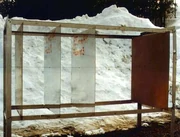
API - less effective

MK211 Damage on Duralumin Plates
Target consisting of an initial plate of 2mm Dural with witness screens of 2mm Al with airspace 0.4 m. Fragmentation screen in rear of 1.25mm mild steel placed 2 m behind the initial plate.
Chronologically, the MP will penetrate, delay, function, fragment, blast and incendiary effect, until beyond 25 cm in the back of the target. We will have approximately 40 fragments of which 20 of them are effective and also incendiary compound fragments for more than 10m.
The deformation of the jacket was in the area of 3mm, which is necessary to ignite the incendiary. When fired against a 2mm dural plate at 200m, the projectile shall produce an incendiary flash, according to the NATO requirement, within 60 cm behind target plate.
As you can see the API has nothing on the amount of damage the MK211 can do - on saying this you can see why it wouldn't be as likely to be used when civilians are around.
Notice how the fragments are the perfect height for hitting a human-size target.
| MP NM140 | MP-T NM160 | AP-S NM173 | |
| Penetration | 11 mm Armour in 45° at 1000 m | 11 mm Armour in 45° at 1000 m | 11 mm Armour in 30° NATO at 1500 m |
| Fragmentation | Approx. 20 effective fragments after hitting 2 mm Duralumin | Approx. 20 effective fragments after hitting 2 mm Duralumin | _ |
| Incendiary effect | Ignition of JP4 and JP8 ammunition | Ignition of JP4 and JP8 ammunition | _ |
| Accuracy Grade At 550 m (Mean radius) | < 15 cm | < 25 cm | < 15 cm |
| Tracer | _ | Red tracer 50 – 1500 m | _ |
| Safety | All types are safe in transport, storage and handling. Drop test from 15 m with safe firing after drop. Comply with requirements in NATO standards and Stanag for 12.7 mm. | ||
Technical Data[]
The Model 95SP displays the full capability of the Nammo Raufoss NM-140 Grade A cartridge. (U.S. nomenclature for this ammo is MK-211.) The NM-140 Grade A used by the Spanish Army, Navy and Air Force is assembled in Norway with Canadian brass and exhibits the same basic behavior of the U.S. MK-211. The Model 95SP system has demonstrated consistent 1.5 MOA accuracy at 1,000 meters, sometimes even better than that, with the NM-140 Grade A. Some also estimate good penetration effects of up to 25mm.
Methodology[]
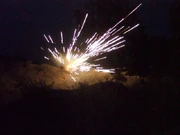
MK211 Strike 1
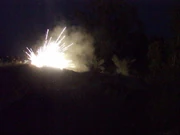
MK211 Strike 2
This is a run through what happens from shot to hit and after. It is a group of events that all happen within a few short seconds:
- Round fired,
- after exiting the barrel, the rotation of the round will cause the incendiary to mix and compress which forms a cone shape of pressure at the tip of the round, forming a pocket of air in the tip and the copper jacket heats up to above normal temperature of other rounds,
- round hits the target, causes adiabatic pressure, a force required in order to discharge the tungsten penetrator, and even causing some adiabatic pressure on RHA, rolled homogeneous armour, which sometimes causes cracks (but most of the time causing the penetrator to fracture and there is less chance of causing cracks on military-grade armor),
- the pocket of air compresses which causes the incendiary mix to ignite, causing a tiny-RDX charge to explode causing fragmentation, cracking effects and damage on the armor, kind of creating a mini-shape charge,
- the round penetrates by sending the tungsten penetrator (.27 calibre armor-piercing tungsten carbide penetrator used in SLAP rounds) forward through the target at 4,000 ft per second, which most of the time strips the jacket off as it enters the target - locking the jacket against the surface, there is a delayed pyrotechnic-train ignition to send more compositions and RDX inside which takes time to burn (this delay takes a millisecond),
- as the penetrator pushed past it pushes some compositions inside but creates a suction or drag that brings the rest in, RDX burns to detonation (sometimes going as far as 40 cm before detonation), blast radius of explosion which will kill human targets close to it and some small-scale shrapnel-like effects of the round and material (it will fragment material near to the blast and also bring in fragments due to the first RDX charge going off earlier)
- fragmenting, which will cause up to 40 fragments to shoot out at around 200 to 400 meters per second in a 30-45 degree direction - 20 of these fragments being "successful" in hitting around and onto the target - the rest of the fragments going off at other angles which will injure others nearby,
- as well as sending the incendiary mixture mentioned before and high explosive effects inside, white-hot jolts of zirconium sparks from the zirconium particles (produced by the zirconium powder) are sent inside so any explosive vapours or flammable substance is instantly set on fire or explodes, this burns at a very high temperature - so hot that it can ignite jet fuel, burning clothes and flesh, it is not easily extinguished, and can last for 10 minutes,
- and the projectile (penetrator) still pushes through - even ricocheting around inside the vehicle causing maximum damage.
It is basically a shotgun blast after penetrating - anyone in its way will no doubt be killed and even more will be seriously injured within the vicinity of around 5-20m. As well as it setting gases and clothing on fire, the penetrator still pushing through would no doubt kill if it entered the upper body or an artery.
If the target offers little resistance then the lack of frictional heating will prevent the incendiary from igniting and the high explosive from detonating. The triggering of the explosive charge is dependent upon the resistance of the target. The difference between soft and hard targets can cause malfunctions with the round.
Variants[]
There are two types of MK211, Class A and B - sometimes called Grade A or B, High grade and Low grade.
- Class A - tungsten carbide penetrator, better accuracy. Will penetrate half an inch of steel at 1,100yards, 671 grain bullet, 215 grain penetrator, military grade.
- Class B - steel penetrator, less penetration, less accuracy as Class A, civilian market.
Several different American manufacturers - with licensing from Nammo - make the round which could make some rounds act differently to others, therefore a difference between Class A and B and different manufacturers.
How it ignites[]
To break down the topic and make it easier to understand, the round penetrates with help of a small-RDX explosion but that does not use up all the RDX, the incendiary and zirconium sparks will help the RDX burn - the RDX continues to burn until it reaches detonation point when it gets to a certain temperature - this all happens in milliseconds but that is more than enough time for the RDX to get within the target and cause maximum damage.
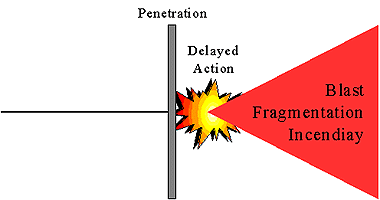
The Multi-Purpose design excludes the use of a mechanical fuse, which has been replaced by a pyrotechnical ignition train providing delayed action in the target, penetration, fragmentation and incendiary effects. The pyrotechnical ignition train delays the amount that the RDX burns and how quickly - causing it to penetrate behind the impact spot before turning from burning to detonation mode, it detonates around 30 cm past the impact spot of a soft target but less in a hard target, around 10 cm.
The standard design of Multipurpose ammunition (20 – 40mm) consist of an aluminum nose cap press filled with an incendiary charge on top of the shell body (heat treated steel) which again is press filled with a High-Explosive charge and an incendiary charge. The projectile can also be equipped with a tracer and a self-destruct or air-burst element.
The 12.7mm Multipurpose projectile differs from the standard design by using a tungsten carbide hardcore to increase penetration capabilities and being encased in a copper jacket. Since Multipurpose ammunition is a fuse-less design and do not have any sensitive primary high explosive components (only secondary high explosive - PETN or RDX) it does not have the safety risk associated with fused projectiles and does not produce dangerous unexploded ordnance, or duds. So it is safe to use at the range or in a combat zone.
Functioning of the Multipurpose projectile is obtained by hitting the target (light or heavy) inducing a fast deformation of the nose cap which is press filled with the incendiary charge. Upon reaching the ignition criteria for the incendiary charge the charge will start burning and subsequently ignite the HE charge resulting in the fragmentation of the shell body. Sensitivity is dependent on the deformation speed of the nose cap and the high speed associated with a projectile travelling down the trajectory is needed to obtain the necessary sensitivity.
It has around the same destructive power as 20mm rounds, but don't let this lead you to believe it can penetrate as well or cause splash damage like 20mm rounds - it cannot - though its fragments may travel a whole 20 meters.
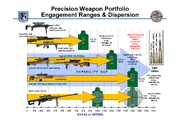
As you can tell by the picture, it's pretty damn accurate even out to 1,500m, it has been said to be the most accurate .50 caliber round but needs a whole new rangecard to set-up in order to be able to fire it accurately. More on accuracy below.
It has a 25% mobility kill rate at 1,500m on light-skinned vehicles - igniting in the engine block would completely knock the engine out of action. Fractures rates become more common at longer ranges and on usual angles - though it is made to explode properly on oblique angles.
Accuracy[]
The MP NM140 round has excelled in accuracy, exhibiting a mean radius of 40 – 70mm at 550m with most of the lots around 55mm. This translates around 1 MOA if we rate the round with civilian specs, which is fairly good when considering all the other specs the bullet has to comply with.
Nammo has decided to certify lower accuracy performances on its MP rounds. They should rate the ammo with the accuracy that it is capable of achieving. Assembly of ammunition outside the Raufoss factory makes may effect some quality, but I still think that the NM140—and on the same line the U.S. made MK-211—should be rated around 100mm MR. The ammunition assembled in the U.S. has demonstrated to be up to these specs and with the MK-211 you can expect around 1.5 MOA accuracy out of the box.
The tracer version (MP-T NM140) has less accuracy than the non-tracer version and should be taken into account at around <25 cm at 550m
Penetration Ability[]
Global security says this round can penetrate around 11mm of RHA at 1000m on a 45 degree angle. Other results suggest it could penetrate 50mm of RHA but did not state the distance. Nammo studies say it can penetrate half an inch at around 1,000m. With the M2 browning machinegun it's effectiveness is increased with a larger rate of fire and a flatter trajectory.
One inch thick RHA - API penetrated but did not continue through, the SLAP round exited completely through - this gives you an idea of the penetrability capabilities of the SLAP round when comparing it with the MK211 - and also what the tungsten penetrator can do.
In the heavy-armor bullet hole the jacket and steel shell body are stripped off the penetrator, which continues into and through the armor. In this kind of target nearly all of the blast, fragmentation and incendiary effect stays in front of the target. The penetrator goes through the armor without eroding.
When confronted with heavy armor such as hardened steel of more than an inch, the effect is as follows: The jacket and shell body material has melted together with and into the armor and form a ring round the hole from the penetrator. The diameter of the hole is the same as the penetrator itself, 7mm.
The penetrator will, in most cases, break up in the moment it passes the armor, and together with fragments from the armor itself, give significant post armor effect. The velocity on these fragments behind a 22mm armor plate at a distance of 100 meters will be between 200 and 400 meters per second, and some of the fragments have the energy to penetrate a 1.5mm steel plate. This means that after the tungsten carbide penetrator passes though the barrier or vehicle, you still have several supersonic fragments capable of considerable ricochet if going into enclosed areas.
MK211 Penetration Tests[]
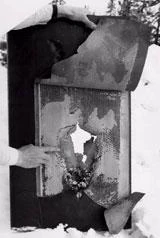
MK211 Damage
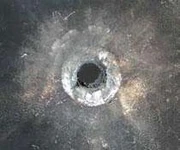
MK211 vs Armor Plate
- 3 and a half inch manhole cover at 30 degrees at 100 yards - MK211 went straight through and burnt the wood behind the target.
- 1/2inch steel iron maiden at 300m to 500m - it completely penetrated.
- 2xCement blocks at around eight inches - ballistic gel within both blocks at the same consistency as human tissue - it penetrated both concrete blocks, completely penetrating the first, through the ballistic gel and through the last. It took actual cement material through the actual wound - a ballistics expert said you could have had people back-to-back and it would have gone through all three.
- One Cinderblock at 100 yards - completely tore it apart, kind of threw it in the air.
- Multiple Cinderblocks at 100 yards - penetrated 4 of the blocks and because of tumbling and yawing action it penetrated completely through the top.
- 2inch thick steel track at 100 yards - went straight through and causes a crack on the plate along.
- 3/4inch thick bullet-proof glass at 100 yards - completely penetrated and caused burning for more than 30 seconds after the round hit and also caused burning downrange a whole 30 yards past impact.
- 10x MK211 Shots on a 600 pound safe at 100 yards - jacket was stripped away and there was heavy fragmentation and burning effects within the safe. 3 out of the 10 tungsten carbide penetrators did not penetrate the back of the safe but completely penetrated the front - one penetrator came through completely parallel vice-perpendicular to the angle.
- On a 90 degree angle it has penetrated 2inches of RHA (Janes Defence Review).
References & External Links[]
- History Channel's: 'Sniper Within The Crosshairs'
- Numerous After-Action Reports of this round in action and it's superior effects
- YouTube videos posted by MK211 users
- USMC Instructional Video of Terminal Ballistics with the MK211 - http://www.youtube.com/watch?v=-NCJFI7T6Zc
- http://www.faqs.org/patents/app/20080229963
- http://www.globalsecurity.org/military/systems/munitions/mk211.htm
- http://en.wikipedia.org/wiki/Raufoss_Mk_211
- http://www.dtic.mil/ndia/22ndISB2005/wednesday/friis.pdf
- http://www.dtic.mil/ndia/2009infantrysmallarms/thursdaysessionxi8503.pdf
- http://www.dtic.mil/ndia/2009infantrysmallarms/thursdaysessionxi8503.pdf
- http://www.mil.no/multimedia/archive/00036/Virkningen_av_12_7mm_36061a.pdf
- http://www.dtic.mil/ndia/2009infantrysmallarms/thursdaysessionxi8503.pdf
- http://web.archive.org/web/20060519021942/http://www.teol.uu.se/noha/masters/moosberg.pdf